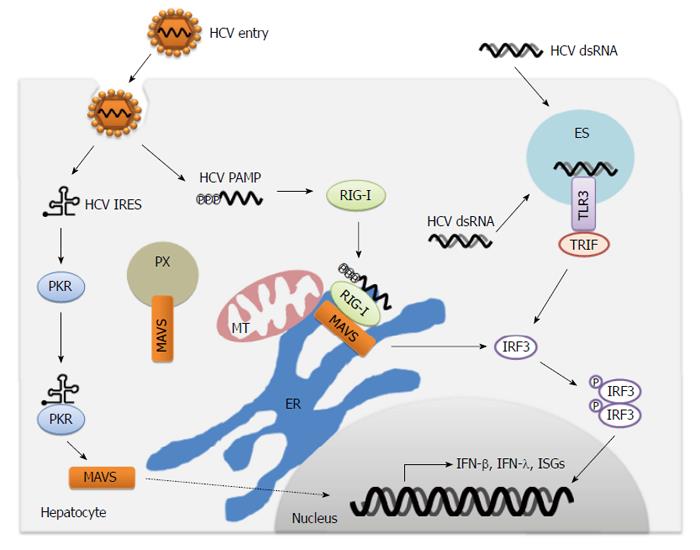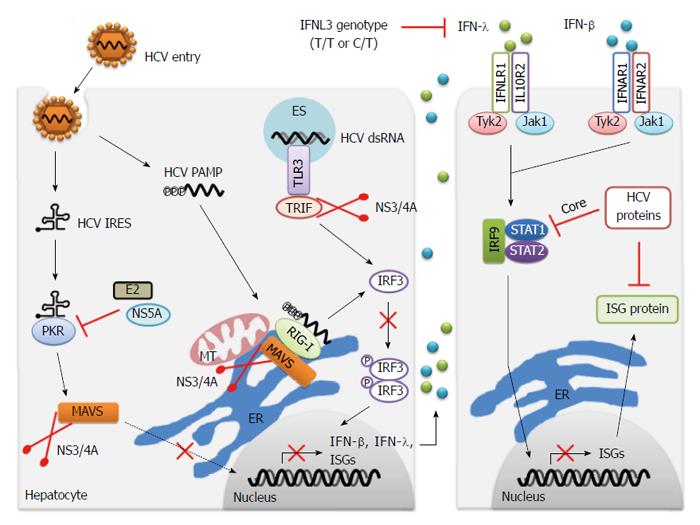Copyright
©The Author(s) 2015.
World J Gastroenterol. Apr 7, 2015; 21(13): 3786-3800
Published online Apr 7, 2015. doi: 10.3748/wjg.v21.i13.3786
Published online Apr 7, 2015. doi: 10.3748/wjg.v21.i13.3786
Figure 1 Immune sensing of hepatitis C virus by pattern recognition receptors.
During hepatitis C virus (HCV) infection, PKR and RIG-I recognize dsRNA constructed in the HCV IRES and HCV PAMP with 5’-triphosphate plus 3’poly-U/UC region, respectively. In the late period of infection, HCV dsRNA from viral replication intermediates or extracellular dying cells is detected by TLR3. Activation of pattern recognition receptors (PRRs) leads to the transduction of signaling through adaptor protein MAVS or TRIF, and subsequent phosphorylation and dimerization of IRF3 to induce the production of IFN-β, IFN-λ, ISGs and proinflammatory cytokines. MT: Mitochondria; ER: Endoplasmic reticulum; ES: Endosome; PX: Peroxisome; MAVS: Mitochondrial antiviral signaling; PAMP: Pathogen-associated molecular pattern; IFN: Interferon; TRIF: TIR-domain-containing adaptor-inducing interferon-β.
Figure 2 Innate immune evasion of hepatitis C virus infection.
Multiple strategies to disrupt both IFN induction and response pathways are responsible for chronic hepatitis C virus (HCV) infection during viral infection. Notably, HCV NS3/4A protease cleaves the adaptor proteins MAVS and TRIF, contributing to the blockage of downstream signaling of PKR, RIG-I and TLR3, and prevention of IFN production. HCV E2 and NS5A proteins suppress the function of PKR by direct binding to this kinase. IFN-β and IFN-λ bind to their distinct receptors and induce the formation of IFN-stimulated gene factor-3 (ISGF3), comprising phosphorylated STAT1, STAT2 and IRF9 through the common JAK/STAT pathway. HCV core and other viral proteins inhibit the activation of STAT signaling, and therefore repress the production of ISGs. The function of specific ISG protein is also suppressed by HCV proteins. Additionally, the unfavorable IFNL3 genotype (T/T or C/T) leads to less expression of IFN-λ, which attenuates the antiviral effect of IFN-λ on HCV infection. MT: Mitochondria; ER: Endoplasmic reticulum; ES: Endosome; PAMP: Pathogen-associated molecular pattern; IRES: Internal ribosomal entry site; TLR: Toll-like receptor; IFN: Interferon; MAVS: Mitochondrial antiviral signaling; ISGs: IFN-stimulated genes; TRIF: TIR-domain-containing adaptor-inducing interferon-β.
- Citation: Yang DR, Zhu HZ. Hepatitis C virus and antiviral innate immunity: Who wins at tug-of-war? World J Gastroenterol 2015; 21(13): 3786-3800
- URL: https://www.wjgnet.com/1007-9327/full/v21/i13/3786.htm
- DOI: https://dx.doi.org/10.3748/wjg.v21.i13.3786










